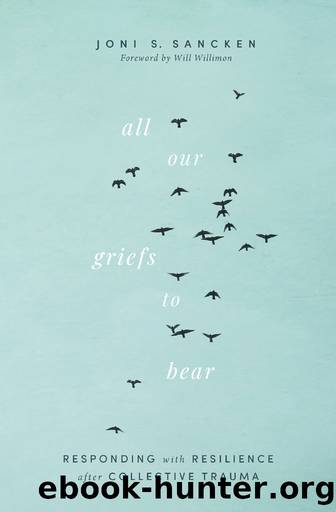All Our Griefs to Bear: Responding with Resilience after Collective Trauma by Joni S. Sancken

Author:Joni S. Sancken
Language: eng
Format: epub
Publisher: MennoMedia
Published: 2022-09-02T00:00:00+00:00
Three
Storytelling
In my preaching classes, I regularly give a lecture that discusses types of illustrations that can be useful in a sermon. The lecture culminates with a focus on stories. Stories are ideal for preaching because they allow something small and particular to serve as an entry point into something larger. The details and elements of stories elicit responses and resonance with listeners, inviting them to participate in making meaning from what they are hearing, to make connections to their own lives. Stories can shape our understandings of identity and purpose. Stories from our world that bear witness to the gospel are key ingredients in sermons that nurture faith and encourage hope and resilience.
In a polarized political climate, stories can also seem like tinder for fires of division that may be smoldering in communities and congregations. When a Tennessee school board banned Art Spiegelmanâs graphic novel about the Nazi Holocaust, sales of the book spiked and both social and traditional media outlets exploded with opinions.1 This is only the latest skirmish in public schools concerning how and whose history is taught. In my own local school district, anxiety focused on critical race theory and how gender identity is discussed at school caused some tense letters to the editor and a contentious school board battle.
Disputes over how to tell the story of human history are not new. On a recent podcast, author and historian Tamim Ansary described historical events as bricks and beams, and narrative as the tool that turns them into something coherent like a cathedral.2
We live in a time when many formerly accepted narratives of history are rightly being dismantled. Events are being pried loose, and our cultural âcathedralsâ are crashing down. Deconstruction can be healing when it uncovers buried truths and validates those whose stories have been hidden. But the loss of common narratives and agreed-upon understanding of our own past can also be destabilizing, painful, and scary.
Trauma serves as its own kind of wrecking ball to the narrative cathedrals we construct in our own lives and communities. Trauma dismantles narrative threads that give life meaning, destroys coherence, and understandably calls identity, relationships, and purpose into question. In the heartbreaking travelogue The Shadow of Imana: Travels in the Heart of Rwanda, artist Véronique Tadjo describes the traumatized state of an entire culture that struggles to engage with the enormity and horror of the aftermath of the Rwandan genocide of 1994. Her perspective is important, as her descriptions and reflections offer us a set of lenses to bear witness to humanity unraveled. The book is a stream of particularities and observations, a mix of some narrative elements but lacking an overarching narrative whole. All the people and places in her book have been deeply impacted by the trauma of genocide. In one part of her book, she describes how individual bodies were exhumed from mass graves, identified, and examined closely as examples standing in for the larger whole.3 The places she visits and the diverse people she meets similarly serve as stand-ins for a larger whole.
Download
This site does not store any files on its server. We only index and link to content provided by other sites. Please contact the content providers to delete copyright contents if any and email us, we'll remove relevant links or contents immediately.
| Adult Ministry | Children's Ministry |
| Counseling & Recovery | Discipleship |
| Evangelism | Missions & Missionary Work |
| Preaching | Sermons |
| Youth Ministry |
Victory over the Darkness by Neil T. Anderson(2815)
The Rape Of Nanking by Iris Chang(2773)
Chosen by God by R. C. Sproul(2122)
Habits of Grace by David Mathis(1943)
Crash the Chatterbox by Steven Furtick(1939)
Knowing God by J.I. Packer(1804)
How To Be Born Again by Billy Graham(1730)
A Prophet with Honor by William C. Martin(1682)
Gospel-Shaped Marriage by Chad van Dixhoorn(1680)
Peace with God by Billy Graham(1643)
Confronting Christianity by Rebecca McLaughlin(1558)
God's Smuggler by Brother Andrew(1509)
Angel Dreams by Virtue Doreen Virtue Melissa(1447)
Whisper by Mark Batterson(1421)
Missionaries by Norman Lewis(1394)
The School of Biblical Evangelism by Ray Comfort(1389)
The Truth War by John MacArthur(1387)
The Poems of Rowan Williams by Rowan Williams(1323)
Do Greater Things by Robby Dawkins(1292)
